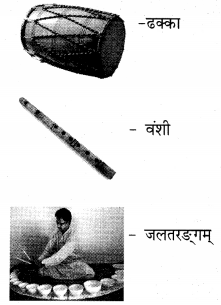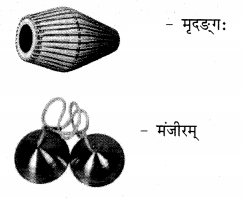We have given detailed NCERT Solutions for Class 9 Sanskrit Shemushi Chapter 2 स्वर्णकाकः Questions and Answers come in handy for quickly completing your homework.
Shemushi Sanskrit Class 9 Solutions Chapter 2 स्वर्णकाकः
Class 9 Sanskrit Shemushi Chapter 2 स्वर्णकाकः Textbook Questions and Answers
अभ्यासः
प्रश्न 1.
एकपदेन उत्तर लिखत –
(क) माता काम् आदिशत्?
(ख) स्वर्णकाक: कान् अखादत्?
(ग) प्रासादः कीदृशः वर्तते?
(घ) गृहमागत्य तया का समुद्घटिता?
(ङ) लोभाविष्टा बालिका कीदृशीं मञ्जूषां नमति?
उत्तर:
(क) पुत्रीम्
(ख) तण्डुलान्
(ग) स्वर्णमयः
(घ) मञ्जूषा
(ङ) बृहत्तमाम्
प्रश्न 2.
अधोलिखितानां प्रश्नानाम् उत्तराणि संस्कृतभाषया लिखत –
(क) निर्धनायाः वृद्धायाः दुहिता कीदृशी आसीत्?
(ख) बालिकया पूर्व कीदृशः काकः न दृष्टः आसीत्?
(ग) निधनायाः दुहिता मञ्जूषायां कानि अपश्यत?
(घ) बालिका किं दृष्ट्वा आश्चर्यचकिता जाता?
(ङ) गर्विता बालिका कीदृशं सोपानम् अयाचत् कीदृशं च प्राप्नोत्?
उत्तर:
(क) निर्धनायाः वृद्धायाः दुहिता विनम्रा मनोहरा च आसीत्।
(ख) बालिकया पूर्व एतादृशः स्वर्णपक्षः रजतचञ्चुः स्वर्णकाकः न दृष्टः आसीत्।
(ग) निर्धनायाः दुहिता मञ्जूषायां महाहाणि हीरकाणि अपश्यत्।
(घ) बालिका वृक्षस्य उपरि स्वर्णमयं प्रासादं दृष्ट्वा आश्चर्यचकिता जाता।
(ङ) गर्विता बालिका स्वर्णमय सोपानम् अयाचत् ताम्रमयं च प्राप्नोत्।
प्रश्न 3.
(अ) अधोलिखितानां शब्दानां विलोमपदं पाठात् चित्वा लिखतशब्दाः विलोमपदानि –
शब्दाः – विलोमपदानि
(क) पश्चात् – ………..
(ख) हसितुम् – ………
(ग) अधः – ……………
(घ) श्वेतः – ………….
(ङ) सूर्यास्त: – ………….
(च) सुप्तः – …………..
उत्तर:
शब्दाः – विलोमपदानि
(क) पश्चात् x पूर्वम्
(ख) हसितुम् x रोदितुम्
(ग) अधः x उपरि
(घ) श्वेतः x कृष्णः
(ङ) सूर्यास्त: x सूर्योदयः
(च) सुप्तः x प्रबुद्धः
(आ) सन्धिं कुरुत –
(क) नि + अवसत् – ………….
(ख) सूर्य + उदयः – ………….
(ग) वृक्षस्य + उपरि – ………….
(घ) हि + अकारयत् – ………….
(ङ) च + एकाकिनी – ………….
(च) इति + उक्त्वा – ………….
(छ) प्रति + अवदत् – ………….
(ज) प्र + उक्तम् – ………….
(झ) अत्र + एव – ………….
(ञ) तत्र + उपस्थिता – ………….
(ट) यथा + इच्छम् – ………….
उत्तर:
(क) नि + अवसत् – न्यवसत्
(ख) सूर्य + उदयः – सूर्योदयः
(ग) वृक्षस्य + उपरि – वृक्षस्योपरि
(घ) हि + अकारयत् – ह्यकारयत्
(ङ) च + एकाकिनी – चैकाकिनी
(च) इति + उक्त्वा – इत्युक्त्वा
(छ) प्रति + अवदत् – प्रत्यवदत्
(ज) प्र + उक्तम् – प्रोक्तम्
(झ) अत्र + एव – अत्रैव
(ञ) तत्र + उपस्थिता – तत्रोपस्थिता
(ट) यथा + इच्छम् – यथेच्छम्
प्रश्न 4.
स्थूलपदान्यधिकृत्य प्रश्ननिर्माणं कुरुत –
(क) ग्रामे निर्थना स्वी अवसत्।
(ख) स्वर्णकाकं निवारयन्ती बालिका प्रार्थयत्।
(ग) सूर्योदयात् पूर्वमेव बालिका तत्रोपस्थिता।
(घ) बालिका निर्धनमातुः दुहिता आसीत्।
(ङ) लुब्धा वृद्धा स्वर्णकाकस्य रहस्यमभिज्ञातवती।
उत्तर:
(क) ग्रामे का अवसत्?
(ख) कं निवारयन्ती बालिका प्रार्थयत्?
(ग) कस्मात् पूर्वमेव बालिका तत्रोपस्थिता?
(घ) बालिका कस्याः दुहिता आसीत्?
(ङ) लुब्धा वृद्धा कस्य रहस्यमभिज्ञातवती?
प्रश्न 5.
प्रकृति-प्रत्यय-संयोगं कुरुत (पाठात् चित्वा वा लिखत) –
(क) वि + लोक् + ल्यप् – ………….
(ख) नि – क्षिप् + ल्यप् – ………….
(ग) आ + गम् + ल्यप् – ………….
(घ) दृश् + क्त्वा – ………….
(ङ) शी + क्त्वा – ………….
(च) लघु + तमप् – ………….
उत्तर:
(क) वि + लोक् + ल्यप् – विलोक्य
(ख) नि – क्षिप् + ल्यप् – निक्षिप्य
(ग) आ + गम् + ल्यप् – आगम्य
(घ) दृश् + क्त्वा – दृष्ट्वा
(ङ) शी + क्त्वा – शयित्वा
(च) लघु + तमप् – लघुतम (लघुतमम्)
प्रश्न 6.
प्रकृति-प्रत्यय-विभागं कुरुत –
(क) रोदितुम् – ………….
(ख) दृष्ट्वा – ………….
(ग) विलोक्य – ………….
(घ) निक्षिप्य – ………….
(ङ) आगत्य – ………….
(च) शयित्वा – ………….
(छ) लघुतमम् – ………….
उत्तर:
(क) रोदितुम् – रुद् + तुमुन्
(ख) दृष्ट्वा – दृश् + क्त्वा
(ग) विलोक्य –वि + लोक् + ल्यप्
(घ) निक्षिप्य – नि + क्षिप् + ल्यप्
(ङ) आगत्य – आ + गम् + ल्यप्
(च) शयित्वा – शी + क्त्वा
(छ) लघुतमम् – लघु + तमप्
प्रश्न 7.
अधोलिखितानि कथनानि कः/का, कं/कां च कथयति –
कथनानि – क:/का – कं/काम्
(क) पूर्व प्रातराशः क्रियताम्। – …………. – ………….
(ख) सूर्यातपे तण्डुलान् खगेभ्यो रक्ष। – …………. – ………….
(ग) तण्डुलान् मा भक्षय। – …………. – ………….
(घ) अहं तुभ्यं तण्डुलमूल्यं दास्यामि। – …………. – ………….
(ङ) भो नीचकाक! अहमागता, महां तण्डुलमूल्यं प्रयच्छ। – …………. – ………….
उत्तर:
कथनानि – कः/का – कं/काम्
(क) पूर्व प्रातराशः क्रियताम्। – स्वर्णकाक: – बालिकाम्
(ख) सूर्यातपे तण्डुलान् खगेभ्यो रक्ष। – वृद्धा माता – पुत्रीम्
(ग) तण्डुलान् मा भक्षया – बालिका – स्वर्णकाकम्
(घ) अहं तुभ्यं तण्डुलमूल्यं दास्यामि। – स्वर्णकाकः – बालिकाम्
(ङ) भो नीचकाक! अहमागता, मां तण्डुलमूल्यं प्रयच्छ। – लुब्धायाः पुत्री – स्वर्णकाकम्
प्रश्न 8.
उदाहरणमनुसृत्य कोष्ठकगतेषु पदेषु पञ्चमीविभक्तेः प्रयोगं कृत्वा रिक्तस्थानानि पूरयत –
यथा-मूषक: बिलाद् बहिः निर्गच्छति। (बिल)
(क) जनः …………. बहिः आगच्छति। (ग्राम)
(ख) नद्यः …………. निस्सन्ति। (पर्वत)
(ग) …………. पत्राणि पतन्ति। (वृक्ष)
(घ) बालकः …………. बिभेति। (सिंह)
(ङ) ईश्वरः …………. त्रायते। (क्लेश)
(च) प्रभुः भक्तं …………. निवारयति। (पाप)
उत्तर:
(क) ग्रामात्
(ख) पर्वतात्/पर्वतेभ्यः
(ग) वृक्षात्
(घ) सिंहात्
(छ) क्लेशात्
(च) पापात्
Class 9 Sanskrit Shemushi Chapter 2 स्वर्णकाकः Additional Important Questions and Answers
अतिरिक्त कार्यम्
प्रश्न 1.
निम्नलिखितम् अनुच्छेदं पठित्वा तदाधारिताना प्रश्नानाम् उत्तराणि लिखत –
1. पुरा कस्मिंश्चिद् ग्रामे एका निधना वृद्धा स्त्री न्यवसत्। तस्याः च एका दुहिता विनमा मनोहरा चासीत्। एकदा माता स्थाल्या तण्डुलान् निक्षिप्य पुत्रीम् आदिशत्। “सूर्यातपे तण्डुलान् खगेभ्यो रक्षा” किञ्चित् कालादनन्तरम् एको विचित्रः काकः समुड्डीय तस्याः समीपम् अगच्छत् ।
(i) एकपदेन उत्तरत (केवलं प्रश्नद्वयमेव)
- वृद्धा स्त्री कीदृशी आसीत्?
- वृद्धायाः कीदृशी दुहिता आसीत्?
- निर्धनास्त्री कुत्र न्यवसत्?
उत्तर:
- निर्धना
- विनम्रा
- कस्मिंश्चिद्ग्रामे
(ii) पूर्णवाक्येन उत्तरत (केवलं प्रश्नमेकमेव)
- किञ्चित्कालानन्तरम् किम् अभवत्?
- दुहिता कीदृशी आसीत?
उत्तर:
- किञ्चित्कालानन्तरम् एको विचित्रः काकः समुड्डीय तस्याः समीपम् अगच्छत्।
- दुहिता विनम्रा मनोहरा चासीत्।
(iii) भाषिककार्यम् (केवलं प्रश्नत्रयमेव)
- अनुच्छेदे ‘न्यवसत्’ इति क्रियापदस्य कर्तृपदं किमस्ति?
- ‘दुहिता विनम्रा’ अनयोः पदयोः विशेषणपदं किम्?
- अस्मिन् अनुच्छेदे ‘धनवती’ इति पदस्य कः विपर्ययः आगतोऽस्ति?
- पुत्री इत्यर्थे किं पदं प्रयुक्तम्?
उत्तर:
- स्त्री
- विनम्रा
- निर्धना
- दुहिता
2. नैतादृशः स्वर्णपक्षो रजतचञ्चुः स्वर्णकाकस्तया पूर्व दृष्टः। तं तण्डुलान् खावन्तं हसन्तञ्च विलोक्य बालिका रोदितुमारब्धा। तं निवारयन्ती सा प्रार्थयत्-“तण्डुलान् मा भक्षया मदीया माता अतीव निर्धना वर्तते।” स्वर्णपक्षः काकः प्रोवाच, “मा शुचः। सूर्योदयात्प्राग् ग्रामाबहिः पिप्पलवृक्षमनु त्वया आगन्तव्यम्। अहं तुभ्यं तण्डुलमूल्यं दास्यामि।” ङ्केप्रहबिता बालिका निनामपि न लेभा
(i) एकपदेन उत्तरत (केवलं प्रश्नद्वयमेव)
- स्वर्णकाकस्य चञ्चुः कीदृशः आसीत्?
- बालिकायाः माता कीदृशी आसीत्?
- क: तण्डुलान् अखादत्?
उत्तर:
- रजतस्य
- निर्धना
- स्वर्णकाक:
(ii) पूर्णवाक्येन उत्तरत (केवलं प्रश्नमेकमेव)
- स्वर्णकाकं निवारयन्ती सा कि प्रार्थयत्?
- स्वर्णकाकः किम् अवदत्?
उत्तर:
- स्वर्णकाकं निवारयन्ती सा प्रार्थयत्-“तण्डुलान् मा भक्षय। मदीया माता अतीव निर्धना वर्तते।”
- स्वर्णकाकः प्रोवाच मा शुचः। सूर्योदयात्प्राग् ग्रामाद्बहिः पिप्पवृक्षमनु त्वया आगन्तव्यम्। अहं तुभ्यं तण्डुलमूल्यं दास्यामि।
(iii) भाषिककार्यम् (केवलं प्रश्नत्रयमेव)
- अनुच्छेदे ‘हसितुम्’ इत्यस्य पदस्य कः विपर्ययः लिखितः?
- रोदितुमारब्धा’ इत्यस्याः क्रियायाः अनुच्छेदे कर्तृपदं कि वर्तते?
- ‘प्रहर्षिता बालिका निद्रामपि न लेभे’। अत्र वाक्ये विशेषणपदं किमस्ति?
- ‘दृष्ट्वा ‘ इत्यर्थे किं पदं प्रयुक्तम्?
उत्तर:
- रोदितुम्
- बालिका
- प्रहर्षिता
- विलोक्य
3. सूर्योदयात्पूर्वमेव सा तत्रोपस्थिता। वृक्षस्योपरि विलोक्य सा च आश्चर्यचकिता सजाता यत् तत्र स्वर्णमयः प्रासादो वर्तते। यदा काकः शयित्वा प्रबुद्धस्तदा तेन स्वर्णगवाक्षात्कथितं “हहो बाले! त्वमागता, तिष्ठ, अहं त्वत्कृते सोपानमवतारयामि, तत्कथय स्वर्णमयं रजतमयम् तासमय वा”? कन्या अवदत्-“अहं निर्धनमातुः दुहिता अस्मि। तानसोपानेनैव आगमिष्यामि।” परं स्वर्णसोपानेन सा स्वर्णभवनम् आरोहत् ।
(i) एकपदेन उत्तरत (केवलं प्रश्नद्वयमेव)
- सूर्योदयात् पूर्वमेव का तत्र उपस्थिता?
- कन्या कस्याः दुहिता आसी?
- काकः किं कृत्वा प्रबुद्धः?
उत्तर:
- बालिका (सा)
- निर्धनमातुः
- शयित्वा
(ii) पूर्णवाक्येन उत्तरत (केवलं प्रश्नमेकमेव)
- स्वर्णगवाक्षात् काकेन किं कथितम्?
- कन्या किं प्रावोचत्?
उत्तर:
- स्वर्णगवाक्षात् काकेन कथितम्-हंहो बाले! त्वमागता, तिष्ठ, अहं त्वत्कृते सोपानमवतारयामि।
- कन्या प्रावोचत् अहं निर्धनमातुर्दुहिताऽस्मिा ताम्रसोपानेनैव आगमिष्यामि।
(iii) भाषिककार्यम् (केवलं प्रश्नत्रयमेव)
- ‘अधः’ इत्यस्य पदस्य कः विपर्ययः अनुच्छेदे लिखितोऽस्ति?
- ‘अहं निर्धनमातुः दुहिता अस्मि’। अत्र वाक्ये ‘अहम्’ इति कर्तृपदस्य क्रियापदं किम्?
- अनुच्छेदे ‘ताम्रमयं सोपानम्’ अनयो: पदयोः विशेषणपदं किमस्ति?
- अस्ति’ इत्यर्थे कि पदं प्रयुक्तम्?
उत्तर:
- उपरि
- अस्मि
- ताम्रमयं
- वर्तते
4. चिरकाल भवने चित्रविचित्रवस्तूनि सज्जितानि दृष्ट्वा सा विस्मयं गता। श्रान्तां तां विलोक्य काकः अवदत् “पूर्व लघुप्रातराशः क्रियताम्-वद त्वं स्वर्णस्थाल्यां भोजनं करिष्यसि किं वा रजतस्थाल्याम् उत ताम्रस्थाल्याम्”? बालिका अवदत्-ताप्रस्थाल्याम् एव अहं-“निर्धना भोजनं करिष्यामि।” तदा सा आश्चर्यचकिता सञ्जाता यदा स्वर्णकाकेन स्वर्णस्थाल्यां भोजनं पर्यवेषितम्। न एतादृशम् स्वादु भोजनमद्यावधि बालिका खादितवती। काकोऽववत्-“बालिके! अहमिच्छामि यत् त्वम् सर्वदा अत्रैव तिष्ठ परं तव माता तु एकाकिनी वर्तते। अतः त्वं शीघ्रमेव स्वगृहं गच्छ ।”
(i) एकपदेन उत्तरत (केवलं प्रश्नद्वयमेव)
- कीदृशीं तां विलोक्य काकः प्राह?
- बालिका कीदृशं भोजनम् अद्यावधि न खादितवती?
- कीदृशानिवस्तूनि दृष्ट्वा सा विस्मयं गता?
उत्तर:
- श्रान्ताम्
- स्वादु
- चित्रविचित्रवस्तूनि
(ii) पूर्णवाक्येन उत्तरत (केवलं प्रश्नमेकमेव)
- सा बालिका कथं विस्मयं गता?
- काकः किम् अवदत्
उत्तर:
- चिरकाल भवने चित्रविचित्रवस्तूनि सज्जितानि दृष्ट्वा सा विस्मयं गता।
- काकः अवदत् बालिके। अहमिच्छामि यत्त्वं सर्वदा अत्रैव तिष्ठ पर तव माता तु एकाकिनी वर्तते। त्वं शीघ्रमेव स्वगृहं गच्छ।
(iii) भाषिककार्यम् (केवलं प्रश्नत्रयमेव)
- तदा सा कन्या आश्चर्यचकिता सञ्जाता’। अस्मिन् वाक्ये विशेषणपदं किमस्ति?
- अनुच्छेदे ‘जननी’ इत्यस्य पदस्य कः पर्यायः लिखितः?
- ‘त्वम्’ इत्यस्य कर्तृपदस्य अनुच्छेदे क्रियापदं किमस्ति?
- ‘दृष्ट्वा ‘ इत्यर्थे किम् पदं प्रयुक्तम्?
उत्तर:
- आश्चर्यचकिता
- माता
- तिष्ठ
- विलोक्य
5. इत्युक्त्वा काकः कक्षाभ्यन्तरात् तिनः मञ्जूषाः निस्सार्य तां प्रत्यवदत् “बालिके! यथेच्छ गृहाण मञ्जूषामेकाम्।” लघुतमा मञ्जूषां प्रगृह्य बालिकया कथितम् इयत् एव मदीयतण्डुलानां मूल्यम्। गृहमागत्य तया मञ्जूषा समुद्घाटिता, तस्यां महार्हाणि हीरकाणि विलोक्य सा प्रहर्षिता तहिनाद्धनिका च सजाता ।
(i) एकपदेन उत्तरत (केवलं प्रश्नद्वयमेव)
- काकः कक्षाभ्यन्तरात् कति मञ्जूषाः निस्सारयति?
- कीदृशी मञ्जूषां प्रगृह्य बालिका कथितम्?
- किं विलोक्य सा प्रहर्षिता सञाता?
उत्तर:
- तिस्रः
- लघुतमाम्
- हीरकाणि
(ii) पूर्णवाक्येन उत्तरत (केवलं प्रश्नमेकमेव)
- मञ्जूषायां कानि विलोक्य सा बालिका प्रहर्षिता अभवत्?
- काकः किं अवदत्?
उत्तर:
- मञ्जूषायां महार्हाणि हीरकाणि विलोक्य सा बालिका प्रहर्षिता अभवत्।
- बालिके! यथेच्छं गृहाण मञ्जूषामेकाम्।
(iii) भाषिककार्यम् (केवलं प्रश्नत्रयमेव)
- ‘प्रत्यवदत्’ इति क्रियापदस्य अनुच्छेदे कर्तृपदं किमस्ति?
- अनुच्छेदे ‘सा’ इति कर्तृपदस्य क्रियापदं किम् आगतम्?
- “निष्क्रम्य’ इति पदस्य कः विपर्ययः अत्र अनुच्छेदे लिखितः?
- ‘ग्रहणं कुरु’ इत्यर्थे किं पदं प्रयुक्तम्?
उत्तर:
- काकः
- सजाता
- आगत्य
- गृहाण
6. तस्मिन्नेव ग्रामे एका अपरा लुब्धा वृद्धा न्यवसत्। तस्या अपि एका पुत्री आसीत्। ईयया सा तस्य स्वर्णकाकस्य रहस्यम् ज्ञातवती। सूर्यातपे तण्डुलान् निक्षिप्य तयापि स्वसुता रक्षार्थं नियुक्ता। तथैव स्वर्णपक्षः काकः तण्डुलान् भक्षयन् तामपि तत्रैवाकारयत्। प्रातस्तत्र गत्वा सा काकं निर्भर्त्सयन्ती प्रावोचत्-“भो नीचकाक! अहमागता, मां तण्डुलमूल्यं प्रयच्छ।” काकोऽब्रवीत्-“अहं त्वत्कृते सोपानम् अवतारयामि। तत्कथय स्वर्णमयं रजतमय तासमयं वा।” गर्वितया बालिकया प्रोक्तम्-“स्वर्णमयेन सोपानेन अहम् आगच्छामि।” परं स्वर्णकाकस्तत्कृते तासमयं सोपानमेव प्रायच्छत्। स्वर्णकाकस्तां भोजनमपि तानभाजने एव अकारयत् ।
(i) एकपदेन उत्तरत (केवलं प्रश्नद्वयमेव)
- तस्मिन् एव ग्रामे कीदृशी वृद्धा न्यवसत्?
- स्वर्णकाकः तां बालिका कस्मिन् भोजनम् अकारयत्?
- लुब्धा वृद्धायाः एका का आसीत्?
उत्तर:
- लुब्धा
- ताम्रभाजने
- पुत्री
(ii) पूर्णवाक्येन उत्तरत (केवलं प्रश्नमेकमेव)
- सा वृद्धा ईर्ष्णया किम् अभिज्ञातवतो?
- तस्मिन्नेव ग्रामे एकाऽपरा कीदृशी वृद्धा न्यवसत्?
उत्तर:
- सा वृद्धा ईयया तस्य स्वर्णकाकस्य रहस्यम् अभिज्ञातवती।
- तस्मिन्नेव ग्रामे एकाऽपरा लुब्धा वृद्धा न्यवसत्।
(iii) भाषिककार्यम् (केवलं प्रश्नत्रयमेव)
- अनुच्छेदे ‘अकारयत्’ इति क्रियायाः कर्तृपदं किम्?
- अनुच्छेदे ‘लुब्धा वृद्धा’ इति कर्तृपदस्य क्रियापदं किमस्ति?
- ‘प्रशंसयन्ती’ इति पदस्य कः विपर्ययः अनुच्छेदे आगतः?
- ‘वसति स्म’ इति अर्थ किं पदं प्रयुक्तम्?
उत्तर:
- स्वर्णकाकः
- न्यवसत्
- निर्भर्त्सयन्ती
- न्यवसत्
प्रश्न 7.
प्रतिनिवृत्तिकाले स्वर्णकाकेन कक्षाभ्यन्तरात् तिम्रः मञ्जूषाः तत्पुरः समुत्क्षिप्ताः। लोभाविष्टा सा बृहत्तमा मञ्जूषां गृहीतवती। गृहमागत्य सा तर्षिता यावद् मञ्जूषामुद्घाटयति तावत् तस्या भीषणः कृष्णसर्पो विलोकितः। लुब्धया बालिकया लोभस्य फलं प्राप्तम्। तदनन्तरं सा लोभ पर्यत्यजत् ।
(i) एकपदेन उत्तरत (केवलं प्रश्नद्वयमेव)
- केन तिनः मञ्जूषाः कन्यायाः पुरः समुत्क्षिप्ता:?
- लोभाविष्टा सा कन्या कीदृशीं मञ्जूषां गृहीतवती?
- मञ्जूषाम् उद्घाट्य सा किम् पश्यति?
उत्तर:
- स्वर्णकाकेन
- बृहत्तमाम्
- कृष्णसर्पः
(ii) पूर्णवाक्येन उत्तरत (केवलं प्रश्नमेकमेव)
- गृहमागत्य यदा सा तर्षिता मञ्जूषाम् उद्घाटयति तदा कं विलोकयति?
- लुब्धया बालिकया कस्य फल प्राप्तम्?
उत्तर:
- गृहमागत्य यदा सा तर्षिता मञ्जूषाम् उद्घाटयति तदा तस्यां भीषणं कृष्णसर्प विलोकयति।
- लुब्धया बालिकया लोभस्य प्राप्तम्।
(iii) भाषिककार्यम् (केवलं प्रश्नत्रयमेव)
- अनुच्छेदे ‘समुत्क्षिप्ताः’ इति क्रियायाः कर्तृपदं किम्?
- अस्मिन् अनुच्छेदे ‘लोभाविष्टा’ इति विशेषणं कस्यै आगतम्?
- ‘तदनन्तरं सा लोभं पर्यत्यजत्’। अत्र अव्ययपदं किमस्ति?
- तस्य समक्षे’ इत्यर्थे किं पदं प्रयुक्तम्?
उत्तर:
- स्वर्णकाकेन
- बालिकार्य
- अनन्तरम्
- तत्पुरः
प्रश्न 2.
निम्नवाक्येषु रेखाङ्कित पदानां स्थानेषु प्रश्नवाचकं पदं लिखत –
प्रश्न 1.
पुरा कस्मिंश्चिद् ग्रामे एका वृद्धा न्यवसत्।
(क) क;
(ख) का
(ग) किम्
(घ) के
उत्तर:
(ख) का
प्रश्न 2.
तस्याः दुहिता विनम्रा मनोहरा च आसीत्।
(क) का
(ख) कीदृशम्
(ग) कीदृशः
(घ) कीदृशी
उत्तर:
(घ) कीदृशी
प्रश्न 3.
सा पुत्रीम् आदिदेश।
(क) काम्
(ख) कम्
(ग) किम्
(घ) कथम्
उत्तर:
(क) काम्
प्रश्न 4.
सूर्यातपे तण्डुलान् खगेभ्यो रक्ष।
(क) कथम्
(ख) काभ्यः
(ग) केभ्यः
(घ) कस्यै
उत्तर:
(ग) केभ्यः
प्रश्न 5.
तदा एक: विचित्रः काकः समुड्डीय ताम् उपाजगाम।
(क) के
(ख) काः
(ग) क:
(घ) कीदृशः
उत्तर:
(ग) क:
प्रश्न 6.
सा प्रार्थयत् – तण्डुलान् मा भक्षय।
(क) का
(ख) कः
(ग) के
(घ) काः
उत्तर:
(क) का
प्रश्न 7.
प्रहर्षिता बालिका निद्राम् अपि न लेभे।
(क) कथम्
(ख) कीदृशी
(ग) कीदृशः
(घ) कीदृशम्
उत्तर:
(ख) कीदृशी
प्रश्न 8.
अहं तुभ्यं तण्डुलमूल्यं प्रदास्यामि।
(क) कम्
(ख) कस्यै
(ग) केभ्यः
(घ) काभ्यः
उत्तर:
(ख) कस्यै
प्रश्न 9.
वृक्षस्य उपरि विलोक्य सा आश्चर्यचकिता सञ्जाता।
(क) का
(ख) काः
(ग) कीदृशः
(घ) कीदृशी
उत्तर:
(घ) कीदृशी
प्रश्न 10.
अहं त्वत्कृते सोपानम् अवतारयामि।
(क) किम्
(ख) कम्
(ग) काम्
(घ) कथम्
उत्तर:
(क) किम्
प्रश्न 11.
अहं निर्धनमातुः दुहिता अस्मि।
(क) कस्याः
(ख) कस्य
(ग) कः
(घ) का
उत्तर:
(क) कस्याः
प्रश्न 12.
श्रान्तां तां विलोक्य काकः प्राह।
(क) के
(ख) कथम्
(ग) काः
(घ) कः
उत्तर:
(घ) कः
प्रश्न 13.
अहं निर्धना ताम्रस्थाल्याम् एव भोजनं करिष्यामि।।
(क) कस्याम्
(ख) के।
(ग) काः
(घ) काभ्यः
उत्तर:
(क) कस्याम्
प्रश्न 14.
तव माता एकाकिनी वर्तते।
(क) किम्
(ख) कस्याः
(ग) के
उत्तर:
(ख) कस्याः
प्रश्न 15.
त्वं शीघ्रमेव स्वगृहं गच्छ।
(क) कीदृशः
(ख) कस्यै
(ग) का
(घ) कुत्र
उत्तर:
(घ) कुत्र
प्रश्न 16.
काकः कक्षाभ्यन्तरात् तिस्रः मञ्जूषाः निस्सार्य अवदत्।
(क) कति
(ख) कथम्
(ग) किम्
(घ) काम्
(घ) का
उत्तर:
(क) कति
प्रश्न 17.
लघुतमा मञ्जूषां प्रगृह्य बालिकया कथितम्।
(क) कम्
(ख) कया
(ग) कस्याः
(घ) काम्
उत्तर:
(ख) कया
प्रश्न 18.
तत्रैव एका अपरा लुब्धा वृद्धा न्यवसत्।
(क) कः
(ख) किम्
(ग) केभ्यः
(घ) का
उत्तर:
(घ) का
प्रश्न 19.
ईय॑या सा स्वर्णकाकस्य रहस्यम् अभिज्ञातवती।
(क) कथम्/कया
(ख) का
(ग) कस्मै
उत्तर:
(क) कथम्/कया
प्रश्न 20.
तथा अपि स्वसुता तण्डुलरक्षार्थं नियुक्ता।
(क) कथम्
(ख) के
(ग) कः
उत्तर:
(घ) का
प्रश्न 21.
महयं तण्डुलमूल्यं प्रयच्छ।
(क) कस्याः
(ख) किम्
उत्तर:
(ख) किम्
प्रश्न 22.
स्वर्णमयेन सोपानेन अहम् आगच्छामि।।
(क) कीदृशेण
(ख) कीदृशी
(ग) काभ्यः
उत्तर:
(क) कीदृशेण
प्रश्न 23.
लोभाविष्टा सा बृहत्तमा मञ्जूषां गृहीतवती।
(क) के
(ख) कस्याः
(ग) का
(घ) कीदृशी
उत्तर:
(घ) कीदृशी
प्रश्न 24.
तस्यां तया भीषणः सर्पः विलोकितः।
(क) कः
(ख) कम्
(ग) का
(घ) कम्
उत्तर:
(क) कः
प्रश्न 25.
लुब्धया बालिकया लोभस्य फलं प्राप्तम्।
(क) क;
(ख) किम्
(ग) केभ्यः
(घ) कस्य
उत्तर:
(घ) कस्य
प्रश्न 3.
निम्नवाक्यानि घटनाक्रमानुसारं पुनर्लिखत –
प्रश्न 1.
- बालिका सूर्योदयात् पूर्वम् एव तत्र उपस्थिता अभवत्।
- यदा मञ्जूषां सा उद्घाटितवती तदा तस्यां महाणि हीरकाणि दृष्ट्वा सा प्रसन्ना जाता।
- यदा काकः शचित्वा प्रबुद्धः जातः तदा सः स्वर्णगवाक्षात् अवदत्।
- कस्मिंश्चिद् ग्रामे एका धनहीना वृद्धा स्त्री अवसत्।
- बालिका अकथयत्-अहं ताम्रस्थाल्यामेव भोजनं करिष्यामि।
- बालिके! त्वम् आगता? तिष्ठ, अहं त्वत्कृते सोपानम् अवतारयामि।
- सा काकं भर्त्सयन्ती अवदत्।
- परं स्वर्णसोपानेन सा स्वर्णभवनम् आससाद।
उत्तर:
- कस्मिंश्चिद् ग्रामे एका धनहीना वृद्धा स्त्री अवसत्।
- बालिका सूर्योदयात् पूर्वम् एव तत्र उपस्थिता अभवत्।
- यदा काकः शचित्वा प्रबुद्धः जातः तदा सः स्वर्णगवाक्षात् अवदत्।
- बालिके। त्वम् आगता? तिष्ठ, अहं त्वत्कृते सोपानम् अवतारयामि।
- परं स्वर्णसोपानेन सा स्वर्णभवनम् आससाद।
- बालिका अकथयत् – अहं ताम्रस्थाल्यामेव भोजनं करिष्यामि।
- यदा मञ्जूषां सा उद्घाटितवती तदा तस्यां महाहाणि हीरकाणि दृष्ट्वा सा प्रसन्ना जाता।
- सा काकं भर्ल्सयन्ती अवदत्।
प्रश्न 2.
- इति उक्त्वा काकः कक्षायाः अभ्यन्तरात् तिस्रः मञ्जूषा: निस्सारयत्।
- लोभाविष्टा सा बृहत्तमा मञ्जूषां गृहीतवती।
- भो नीचकाक! अहम् आगता अस्मि। मह्यं तण्डुलमूल्यं प्रयच्छ।
- किञ्चित् कालात् अनन्तरं एकः विचित्रः काकः तत्र तामुपाजगाम।
- एकस्याः वृद्धायाः एका विनम्रा मनोहरा च कन्या आसीत्।
- कन्या प्रावोचत्-अहं निर्धन मातुः कन्या अस्मि। अतः ताम्र सोपानेन एव आगमिष्यामि।
- तस्मिन्नेव ग्रामे एका अपरा लुब्धा वृद्धा स्त्री अवसत्।
- एकदा सा पुत्रीम् आदिदेश-सूर्यातपे तण्डुलात् खगेभ्यो त्वं रक्ष।
उत्तर:
- एकस्याः वृद्धायाः एका विनम्रा मनोहरा च कन्या आसीत्।
- एकदा सा पुत्रीम् आदिदेश-सूर्यातपे तण्डुलात् खगेभ्यो त्वं रक्ष।
- किञ्चित् कालात् अनन्तरं एक: विचित्रः काकः तत्र तामुपाजगाम।
- कन्या प्रावोचत्-अहं निर्धन मातुः कन्या अस्मि। अतः ताम्र सोपानेन एव आगमिष्यामि।
- इति उक्त्वा काकः कक्षायाः अभ्यन्तरात् तिम्रः मञ्जूषाः निस्सारयत्।
- तस्मिन्नेव ग्रामे एका अपरा लुब्धा वृद्धा स्त्री अवसत्।
- भो नीचकाक! अहम् आगता अस्मि। मह्यं तण्डुलमूल्यं प्रयच्छ।
- लोभाविष्टा सा बृहत्तमा मञ्जूषां गृहीतवती।
प्रश्न 3.
- गृहम् आगत्य यदा सा मञ्जूषाम् उद्घाटयति तदा तस्मिन् एवं कृष्णसर्पम् अपश्यत्।
- हे नीच काक! अहम् आगता अस्मि, मह्यं तण्डुलानां मूल्यं प्रयच्छ।
- तदनन्तरं सा लोभम् अत्यजत्।
- तस्मिन् एवं ग्रामे एका लुब्धा वृद्धा अपि न्यवसत्।
- गर्विता बालिका अवदत्-अहं स्वर्णमयेन सोपानेव एव आगमिष्यामि।
- लुब्धया कन्यया लोभस्य फलं प्राप्तम्।
- तस्याः अपि एका ईर्ष्यालु: कन्या अपि आसीत्।
- सूर्यातपे सापि तण्डुलान् निक्षिप्य स्वसुता तेषां रक्षार्थ नियुक्तवती।
उत्तर:
- तस्मिन् एव ग्रामे एका लुब्धा वृद्धा अपि न्यवसत्।
- तस्याः अपि एका ईर्ष्यालुः कन्या अपि आसीत्।
- सूर्यातपे सापि तण्डुलान् निक्षिप्य स्वसुतां तेषां रक्षार्थ नियुक्तवती।
- हे नीच काक! अहम् आगता अस्मि, महयं तण्डुलानां मूल्यं प्रयच्छ।
- गर्विता बालिका अवदत्-अहं स्वर्णमयेन सोपानेव एव आगमिष्यामि।
- गृहम् आगत्य यदा सा मञ्जूषाम् उद्घाटयति तदा तस्मिन् एवं कृष्णसर्पम् अपश्यत्।
- लुब्धया कन्यया लोभस्य फलं प्राप्तम्।
- तदनन्तर सा लोभम् अत्यजत्।
प्रश्न 4.
निम्न पदानां पर्यायपदानि मेलयत-
पदानि – पर्यायः
- निर्धना – अवदत्
- एकदा – तस्याः समक्षे
- पुरा – शोकं कुरु
- माता – अतीव प्रसन्ना
- शुचः – स्वर्णशरीरम्
- प्रबुद्धः – अद्यपर्यन्तम्
- स्वर्णमयम् – निक्षिप्ताः
- चिरकालम् – दृष्ट्वा
- दुहिता – असन्तुष्टा (उत्कण्ठिता)
- विस्मयम् – एकवारम् (एकस्मिन् दिवसे)
- प्राह – खादन्
- अद्यावधि – प्राचीने काले
- प्रगृह्य – जागरितः
- विलोक्य – दीर्धकालम्
- प्रहर्षिता – जननी
- भक्षयन् – गृहीत्वा
- तत्पुरः – धनहीना
- समुत्क्षिप्ताः – आश्चर्यम्
- पर्यत्यजत् – तुभ्यम्
- तर्षिता – सुता
- त्वत्कृते – त्यक्तवती
उत्तर:
पदानि – पर्यायः
- निर्धना – धनहीना
- एकदा – एकवारम् (एकस्मिन् दिवसे)
- पुरा – प्राचीनेकाले
- माता – जननी
- शुचः – शोकं कुरु
- प्रबुद्धः – जागरितः
- स्वर्णमयम् – स्वर्णशरीरम्
- चिरकालम् – दीर्घकालम्
- दुहिता – सुता
- विस्मयम् -आश्चर्यम्
- प्राह – अवदत्
- अद्यावधि – अद्यपर्यन्तम्
- प्रगृह्य – गृहीत्वा
- विलोक्य – दृष्ट्वा
- प्रहर्षिता – अतीव प्रसन्ना
- भक्षयन् – खादन्
- तत्पुरः – तस्याः समक्षे
- समुत्क्षिप्ताः – निक्षिप्ता:
- पर्यत्यजत् – त्यक्तवती
- तर्षिता – असन्तुष्टा (उत्कण्ठिता)
- त्वत्कृते – तुभ्यम्
प्रश्न 5.
‘क’ स्तम्भे विशेषणानि ‘ख’ स्तम्भे विशेष्याणि दत्तानि। तानि समुचित योजयत –
‘क’ स्तम्भ – ‘ख’ स्तम्भ
- वृद्धा – स्वर्णकाक:
- मनोहरा – माता
- कस्मिंश्चिद् – बालिका
- स्वर्णपक्ष: – भवनम्
- निर्धना – मञ्जूषा
- प्रहर्षिता – सा
- स्वर्णमयम् – काक:
- आश्चर्यचकिता – ग्राम
- प्रबुद्धः – दुहिता
- एकाकिनी – माता
- इयत् – स्त्री
- तिस्रः – मूल्यम्
उत्तर:
‘क’ स्तम्भ – ‘ख’ स्तम्भ
- वृद्धा – स्त्री
- मनोहरा – दुहिता
- कस्मिंश्चिद् – ग्रामे
- स्वर्णपक्ष: – स्वर्णकाकः
- निर्धना – माता
- प्रहर्षिता – बालिका
- स्वर्णमयम् – भवनम्
- आश्चर्यचकिता – सा
- प्रबुद्धः – काकः
- एकाकिनी – माता
- इयत् – मूल्यम्
- तिस्रः – मञ्जूषा








